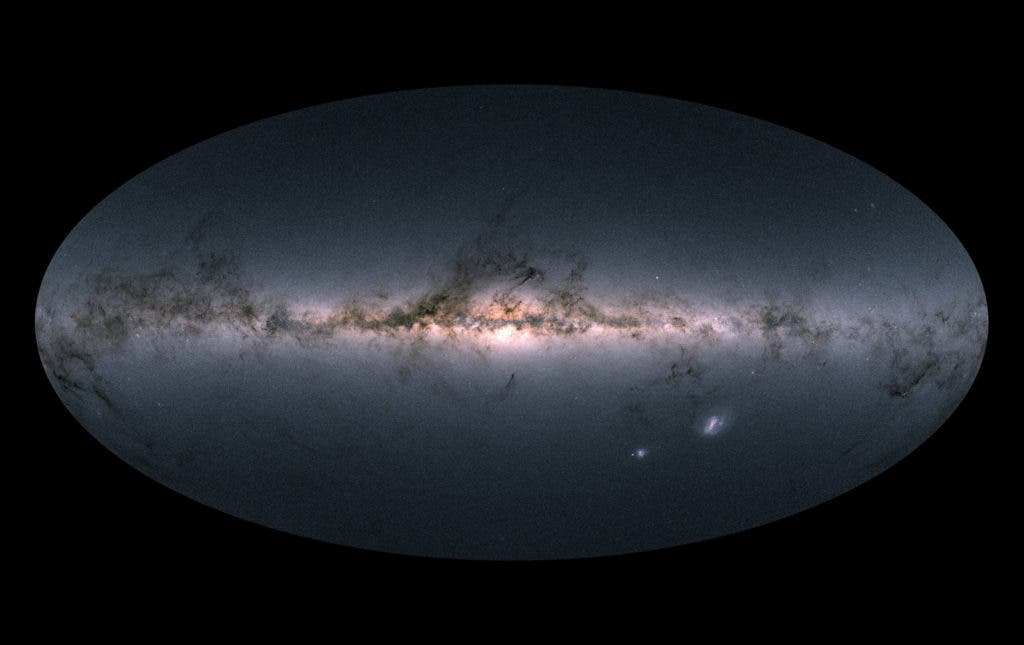
The map shows the total brightness and colour of stars observed by the ESA satellite in each portion of the sky between July 2014 and May 2016. Brighter regions indicate denser concentrations of especially bright stars, while darker regions correspond to patches of the sky where fewer bright stars are observed. Credit: Gaia Data Processing and Analysis Consortium (DPAC).
ESA’s Gaia mission has now released the richest star catalogue to date, accurately pinpointing the position of more than 1.7 billion stars. The painstaking work, which required more than 22 months of charting the sky, will enable astronomers to investigate the formation and evolution of the Milky Way in unprecedented detail.
“The observations collected by Gaia are redefining the foundations of astronomy,” says Günther Hasinger, ESA Director of Science.
“Gaia is an ambitious mission that relies on a huge human collaboration to make sense of a large volume of highly complex data. It demonstrates the need for long-term projects to guarantee progress in space science and technology and to implement even more daring scientific missions of the coming decades.”
The €750 ($920) million Gaia satellite’s journey started in December 2013, and its first data release, which was based on just one year of observations, was published in 2016. This initial survey mapped the distances and motions of two million stars — very impressive, by all means. But, this latest data release, which was collected between 25 July 2014 and 23 May 2016, outshines its predecessor, pinning down the positions of nearly 1.7 billion stars. What’s more, the precision with which some of these stars have been mapped is simply mind-blowing. For instance, some of the brightest stars in the survey have been pinpointed with the same level of precision required for Earthbound observers to be able to spot a Euro coin lying on the surface of the Moon.
“The second Gaia data release represents a huge leap forward with respect to ESA’s Hipparcos satellite, Gaia’s predecessor and the first space mission for astrometry, which surveyed some 118 000 stars almost thirty years ago,” says Anthony Brown of Leiden University, The Netherlands.
Unwinding the Milky Way’s history
Armed with these far more accurate measurements, astronomers can now differentiate between the parallax of stars — the apparent shift in the sky caused by Earth’s yearly orbit around the sun — from their true movements relative to the galactic center. From the most accurate parallax measurements, about ten percent of the total, astronomers can directly estimate distances to individual stars.
All of this is a “big deal” for researchers whose careers are about understanding the Milky Way and its formation, a quest where the accuracy in pinning down the relative movements of its stars is of the utmost importance. Until recently, much of the galaxy’s contents have been obscured by gas and dust, making it difficult to discern its structure from our vantage point. And because the satellite traces how the stars move, scientists can trace their movements back in time, as if winding a clock backward — in the process, which some call galactic archaeology, it’s possible to see how the galaxy evolved over the past 13 billion years.
That’s not all. Gaia also observes objects in our Solar System, like the positions of more than 14,000 known asteroids. An even larger asteroid sample will be compiled in Gaia’s future releases.
Gaia also has locked on to the positions of more than half a million quasars — extremely remote celestial objects, emitting exceptionally large amounts of energy, powered by black holes a billion times as massive as our sun. These objects are used in the survey as beacons that define a reference frame for the celestial coordinates of all other objects in the Gaia catalogue, something that is routinely done in radio waves but now, for the first time, is also available at optical wavelengths.
All in all, scientists expect to make a wealth of new discoveries as a direct result of the new Gaia data release. Already, some astronomers are using the Gaia survey to distinguish between various populations of stars of different ages that are located in different regions of the Milky Way — such as the disc and the halo — and that formed in different ways
“Gaia will greatly advance our understanding of the Universe on all cosmic scales,” says Timo Prusti, Gaia project scientist at ESA.
“Even in the neighbourhood of the Sun, which is the region we thought we understood best, Gaia is revealing new and exciting features.”
Scientific reference: Gerard Gilmore. Gaia: 3-dimensional census of the Milky Way Galaxy, Contemporary Physics (2018). DOI: 10.1080/00107514.2018.1439700.









